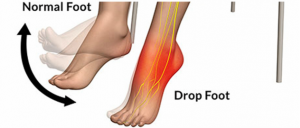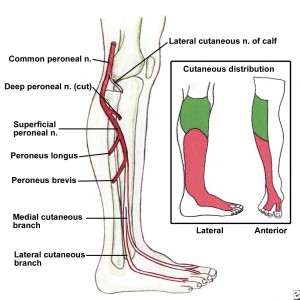Do you or someone you know suffer from foot drop? Foot drop is a gait abnormality in which the dropping of the forefoot happens due to weakness, irritation or damage to a nerve, or paralysis of the muscle/s in the anterior portion of the lower leg. It is usually a symptom of a greater problem, not a disease in itself.
nerve, or paralysis of the muscle/s in the anterior portion of the lower leg. It is usually a symptom of a greater problem, not a disease in itself.
The most common cause of foot drop is injury to the peroneal nerve as it passes around the outside of the knee. The peroneal nerve is a branch of the sciatic nerve that wraps from the back of the knee to the front of the shin and travels down into your foot. Because it sits very close to the surface near your knee, it may be damaged easily. This can be caused by prolonged compression of the nerve while sitting cross-legged or having your leg leaning against something, a sports or impact injury to the knee or lower leg, knee or hip replacement surgery.
Nerves are part of the “electrical wiring” system that carries messages between the brain and the rest of the body. Motor nerves carry messages between the brain and muscles to make the body move. Sensory nerves carry messages between the brain and different parts of the body to signal pain, pressure, and temperature. And most nerves, such as your peroneal, have both sensory and motor components.
Pressure or stretching injuries can cause fibers within the nerve to break. This may interfere with the nerve’s ability to send or receive signals, without damaging the insulating cover, similar to a wire you find in your home or electronic devices. However, nerves can heal, and with time, this injury is likely to fully heal and you can likely make a complete recovery.
When a nerve is cut, both the nerve and the insulation are severed. The end of the fiber farthest from the brain dies., but the end that is closest to the brain does not die and after some time, may begin to heal by developing finger-like sprouts that begins to look for its partner end. If those sprouts reach the other end, your function and/or sensation will be restored. If not, surgery may or may not work to repair the damaged nerve.
 Compression of the peroneal nerve can lead to pain, numbness, and/or weakness to the foot, ankle, or outer portion of your lower leg. Once a nerve is injured the symptoms will typically occur below the site of injury and can last minutes or hours, or with a more severe injury, it can cause months or a lifetime of disability.
Compression of the peroneal nerve can lead to pain, numbness, and/or weakness to the foot, ankle, or outer portion of your lower leg. Once a nerve is injured the symptoms will typically occur below the site of injury and can last minutes or hours, or with a more severe injury, it can cause months or a lifetime of disability.
The common personal also has multiple branches that vary in function. Some branches just innervate our skin and so compression or injury to this portion may only cause numbness or a tingling sensation to our lower leg or foot. And then other branches support our muscles of the lower leg and foot, most notable being the anterior tibialis muscle that controls your ability to lift your foot off the ground.
The tibialis anterior muscle runs along the front to outside portion of your lower leg. It begins just below the outside of your knee, and inserts into your foot, just below the front of the ankle. The most important function of this muscle is to lift the foot during gait so you do not drag your toes on the ground, which can be a fall hazard. It also controls your foot as you strike the ground with your heal during walking, allowing your foot to slowly lower to the ground giving you more stability, and preventing the notorious foot slap that is associated with foot drop. When this happens, likely an AFO will be prescribed to improve that ankle stability and prevent tripping over your toes.
So there you have it. That is the basic anatomy and physiology of foot drop. If you think you may suffer from this condition, or just want to learn more about it. Stop by and see me or another one of our physical therapists today!
Michael Phillip, PT
Physical Therapist – South Office
